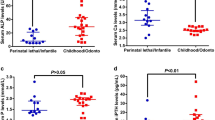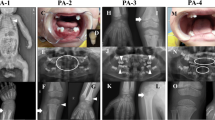Abstract
Hypophosphatasia (HPP) is highly variable in clinical expression and is generally classified into six subtypes. Although it would be beneficial to be able to predict the clinical course from the ALPL genotype, studies on this issue are limited. Here, we aimed to clarify the features of Japanese HPP and the relationships between genotype and clinical manifestations. We analyzed 98 unrelated Japanese patients to investigate the percentage of each clinical form, frequently detected mutations, and the relationship between the genotype and phenotype. Some of the identified mutants were characterized by transfection experiments. Perinatal severe form was the most frequent (45.9%), followed by perinatal benign form (22.4%). Among the 196 alleles, p.Leu520ArgfsX86 (c.1559delT) was detected in 89 alleles, and p.Phe327Leu (c.979T>C) was identified in 23 alleles. All of the homozygotes for p.Leu520ArgfsX86 were classified into perinatal severe form, and patients carrying p.Phe327Leu in one of the alleles were classified into perinatal benign or odonto HPP. Twenty of the 22 patients with perinatal benign HPP were compound heterozygous for p.Phe327Leu and another mutation. Most patients with odonto HPP were found to be monoallelic heterozygotes for dominant-negative mutations or compound heterozygotes with mutants having residual activity. The high prevalence of p.Leu520ArgfsX86 and p.Phe327Leu mutations might underlie the high rate of perinatal severe and perinatal benign forms, respectively, in Japanese HPP. Although ALPL genotyping would be beneficial for predicting the clinical course to an extent, the observed phenotypical variability among patients sharing the same genotypes suggests the presence of modifiers.


Similar content being viewed by others
References
Whyte MP (2016) Hypophosphatasia—aetiology, nosology, pathogenesis, diagnosis and treatment. Nat Rev Endocrinol 12:233–246
Mornet E (2007) Hypophosphatasia. Orphanet J Rare Dis 2:40
Mornet E, Nunes ME (2007) Hypophosphatasia. In: Adam MP, Ardinger HH, Pagon RA, Wallace SE, Bean LJH, Stephens K, Amemiya A (eds) GeneReviews®. University of Washington, Seattle
Wenkert D, McAlister WH, Coburn SP, Zerega JA, Ryan LM, Ericson KL, Hersh JH, Mumm S, Whyte MP (2011) Hypophosphatasia: nonlethal disease despite skeletal presentation in utero (17 new cases and literature review). J Bone Miner Res 26:2389–2398
Ozono K, Yamagata M, Michigami T, Nakajima S, Sakai N, Cai G, Satomura K, Yasui N, Okada S, Nakayama M (1996) Identification of novel missense mutations (Phe310Leu and Gly439Arg) in a neonatal case of hypophosphatasia. J Clin Endocrinol Metab 81:4458–4461
Simon-Bouy B, Taillandier A, Fauvert D, Brun-Heath I, Serre JL, Armengod CG, Bialer MG, Mathieu M, Cousin J, Chitayat D, Liebelt J, Feldman B, Gerard-Blanluet M, Kortge-Jung S, King C, Laivuori H, Le Merrer M, Mehta S, Jern C, Sharif S, Prieur F, Gillessen-Kaesbach G, Zankl A, Mornet E (2008) Hypophosphatasia: molecular testing of 19 prenatal cases and discussion about genetic counseling. Prenat Diagn 28:993–998
Yadav MC, de Oliveira RC, Foster BL, Fong H, Cory E, Narisawa S, Sah RL, Somerman M, Whyte MP, Millan JL (2012) Enzyme replacement prevents enamel defects in hypophosphatasia mice. J Bone Miner Res 27:1722–1734
Whyte MP, Rockman-Greenberg C, Ozono K, Riese R, Moseley S, Melian A, Thompson DD, Bishop N, Hofmann C (2016) Asfotase alfa treatment improves survival for perinatal and infantile hypophosphatasia. J Clin Endocrinol Metab 101:334–342
Okazaki Y, Kitajima H, Mochizuki N, Kitaoka T, Michigami T, Ozono K (2016) Lethal hypophosphatasia successfully treated with enzyme replacement from day 1 after birth. Eur J Pediatr 175:433–437
Kitaoka T, Tajima T, Nagasaki K, Kikuchi T, Yamamoto K, Michigami T, Okada S, Fujiwara I, Kokaji M, Mochizuki H, Ogata T, Tatebayashi K, Watanabe A, Yatsuga S, Kubota T, Ozono K (2017) Safety and efficacy of treatment with asfotase alfa in patients with hypophosphatasia: results from a Japanese clinical trial. Clin Endocrinol (Oxf) 87:10–19
Zurutuza L, Muller F, Gibrat JF, Taillandier A, Simon-Bouy B, Serre JL, Mornet E (1999) Correlations of genotype and phenotype in hypophosphatasia. Hum Mol Genet 8:1039–1046
Mornet E (2015) Molecular genetics of hypophosphatasia and phenotype–genotype correlations. Subcell Biochem 76:25–43
Michigami T, Uchihashi T, Suzuki A, Tachikawa K, Nakajima S, Ozono K (2005) Common mutations F310L and T1559del in the tissue-nonspecific alkaline phosphatase gene are related to distinct phenotypes in Japanese patients with hypophosphatasia. Eur J Pediatr 164:277–282
Matsushita M, Kitoh H, Michigami T, Tachikawa K, Ishiguro N (2014) Benign prenatal hypophosphatasia: a treatable disease not to be missed. Pediatr Radiol 44:340–343
Ikenoue S, Miyakoshi K, Ishii T, Sato Y, Otani T, Akiba Y, Kasuga Y, Ochiai D, Matsumoto T, Ichihashi Y, Matsuzaki Y, Tachikawa K, Michigami T, Nishimura G, Ikeda K, Hasegawa T, Tanaka M (2018) Discordant fetal phenotype of hypophosphatasia in two siblings. Am J Med Genet A 176:171–174
Oyachi M, Harada D, Sakamoto N, Ueyama K, Kondo K, Kishimoto K, Izui M, Nagamatsu Y, Kashiwagi H, Yamamuro M, Tamura M, Kikuchi S, Akiyama T, Michigami T, Seino Y, Namba N (2018) A case of perinatal hypophosphatasia with a novel mutation in the ALPL gene: clinical course and review of the literature. Clin Pediatr Endocrinol 27:179–186
Ishiguro T, Sugiyama Y, Ueda K, Muramatsu Y, Tsuda H, Kotani T, Michigami T, Tachikawa K, Akiyama T, Hayakawa M (2019) Findings of amplitude-integrated electroencephalogram recordings and serum vitamin B6 metabolites in perinatal lethal hypophosphatasia during enzyme replacement therapy. Brain Dev 41(8):721–725
Akiyama T, Kubota T, Ozono K, Michigami T, Kobayashi D, Takeyari S, Sugiyama Y, Noda M, Harada D, Namba N, Suzuki A, Utoyama M, Kitanaka S, Uematsu M, Mitani Y, Matsunami K, Takishima S, Ogawa E, Kobayashi K (2018) Pyridoxal 5'-phosphate and related metabolites in hypophosphatasia: effects of enzyme replacement therapy. Mol Genet Metab 125:174–180
Henthorn PS, Whyte MP (1992) Missense mutations of the tissue-nonspecific alkaline phosphatase gene in hypophosphatasia. Clin Chem 38:2501–2505
Cai G, Michigami T, Yamamoto T, Yasui N, Satomura K, Yamagata M, Shima M, Nakajima S, Mushiake S, Okada S, Ozono K (1998) Analysis of localization of mutated tissue-nonspecific alkaline phosphatase proteins associated with neonatal hypophosphatasia using green fluorescent protein chimeras. J Clin Endocrinol Metab 83:3936–3942
Fauvert D, Brun-Heath I, Lia-Baldini AS, Bellazi L, Taillandier A, Serre JL, de Mazancourt P, Mornet E (2009) Mild forms of hypophosphatasia mostly result from dominant negative effect of severe alleles or from compound heterozygosity for severe and moderate alleles. BMC Med Genet 10:51
Lia-Baldini AS, Muller F, Taillandier A, Gibrat JF, Mouchard M, Robin B, Simon-Bouy B, Serre JL, Aylsworth AS, Bieth E, Delanote S, Freisinger P, Hu JC, Krohn HP, Nunes ME, Mornet E (2001) A molecular approach to dominance in hypophosphatasia. Hum Genet 109:99–108
Komaru K, Satou Y, Al-Shawafi HA, Numa-Kinjoh N, Sohda M, Oda K (2016) Glycosylation-deficient mutations in tissue-nonspecific alkaline phosphatase impair its structure and function and are linked to infantile hypophosphatasia. FEBS J 283:1168–1179
Mornet E, Taillandier A, Peyramaure S, Kaper F, Muller F, Brenner R, Bussiere P, Freisinger P, Godard J, Le Merrer M, Oury JF, Plauchu H, Puddu R, Rival JM, Superti-Furga A, Touraine RL, Serre JL, Simon-Bouy B (1998) Identification of fifteen novel mutations in the tissue-nonspecific alkaline phosphatase (TNSALP) gene in European patients with severe hypophosphatasia. Eur J Hum Genet 6:308–314
Taillandier A, Zurutuza L, Muller F, Simon-Bouy B, Serre JL, Bird L, Brenner R, Boute O, Cousin J, Gaillard D, Heidemann PH, Steinmann B, Wallot M, Mornet E (1172delC) Characterization of eleven novel mutations (M45L, R119H, 544delG, G145V, H154Y, C184Y, D289V, 862+5A, 1172delC, R411X, E459K) in the tissue-nonspecific alkaline phosphatase (TNSALP) gene in patients with severe hypophosphatasia. Mutations in brief no. 217. Hum Mutat 13:171–172
Saglam H, Erdol S, Dorum S (2017) Clinical and genetic findings of Turkish hypophosphatasia cases. J Clin Res Pediatr Endocrinol 9:229–236
Muller HL, Yamazaki M, Michigami T, Kageyama T, Schonau E, Schneider P, Ozono K (2000) Asp361Val mutant of alkaline phosphatase found in patients with dominantly inherited hypophosphatasia inhibits the activity of the wild-type enzyme. J Clin Endocrinol Metab 85:743–747
Whyte MP (2017) Hypophosphatasia: enzyme replacement therapy brings new opportunities and new challenges. J Bone Miner Res 32:667–675
Weiss MJ, Henthorn PS, Lafferty MA, Slaughter C, Raducha M, Harris H (1986) Isolation and characterization of a cDNA encoding a human liver/bone/kidney-type alkaline phosphatase. Proc Natl Acad Sci USA 83:7182–7186
Goseki-Sone M, Orimo H, Iimura T, Miyazaki H, Oda K, Shibata H, Yanagishita M, Takagi Y, Watanabe H, Shimada T, Oida S (1998) Expression of the mutant (1735T-DEL) tissue-nonspecific alkaline phosphatase gene from hypophosphatasia patients. J Bone Miner Res 13:1827–1834
Watanabe A, Karasugi T, Sawai H, Naing BT, Ikegawa S, Orimo H, Shimada T (2011) Prevalence of c.1559delT in ALPL, a common mutation resulting in the perinatal (lethal) form of hypophosphatasia in Japanese and effects of the mutation on heterozygous carriers. J Hum Genet 56:166–168
Mornet E, Yvard A, Taillandier A, Fauvert D, Simon-Bouy B (2011) A molecular-based estimation of the prevalence of hypophosphatasia in the European population. Ann Hum Genet 75:439–445
Greenberg CR, Taylor CL, Haworth JC, Seargeant LE, Philipps S, Triggs-Raine B, Chodirker BN (1993) A homoallelic Gly317–%3eAsp mutation in ALPL causes the perinatal (lethal) form of hypophosphatasia in Canadian mennonites. Genomics 17:215–217
Whyte MP, Essmyer K, Geimer M, Mumm S (1348c) Homozygosity for TNSALP mutation 1348c%3eT (Arg433Cys) causes infantile hypophosphatasia manifesting transient disease correction and variably lethal outcome in a kindred of black ancestry. J Pediatr 148:753–758
Hofmann C, Girschick H, Mornet E, Schneider D, Jakob F, Mentrup B (2014) Unexpected high intrafamilial phenotypic variability observed in hypophosphatasia. Eur J Hum Genet 22:1160–1164
Taillandier A, Domingues C, Dufour A, Debiais F, Guggenbuhl P, Roux C, Cormier C, Cortet B, Porquet-Bordes V, Coury F, Genevieve D, Chiesa J, Colin T, Fletcher E, Guichet A, Javier RM, Laroche M, Laurent M, Lausch E, LeHeup B, Lukas C, Schwabe G, van der Burgt I, Muti C, Simon-Bouy B, Mornet E (2018) Genetic analysis of adults heterozygous for ALPL mutations. J Bone Miner Metab 36:723–733
Acknowledgements
The authors thank all the patients, families, and doctors who contributed to this study. This work was supported by a grant from the Japan Agency for Medical Research and Development (AMED) Practical Research Project for Rare/Intractable Disease Project of Japan (17ek010935h0003), and by Research on rare and intractable diseases, Health, Labour and Welfare Sciences Research Grants (19FC1006).
Author information
Authors and Affiliations
Corresponding author
Ethics declarations
Conflict of interest
Toshimi Michigami, Kanako Tachikawa, Miwa Yamazaki, Masanobu Kawai, Takuo Kubota, and Keiichi Ozono declare that they have no conflict of interest.
Human and Animal Rights and Informed Consent
Informed consent was obtained from the patients or guardians of minor patients.
Additional information
Publisher's Note
Springer Nature remains neutral with regard to jurisdictional claims in published maps and institutional affiliations.
Rights and permissions
About this article
Cite this article
Michigami, T., Tachikawa, K., Yamazaki, M. et al. Hypophosphatasia in Japan: ALPL Mutation Analysis in 98 Unrelated Patients. Calcif Tissue Int 106, 221–231 (2020). https://doi.org/10.1007/s00223-019-00626-w
Received:
Accepted:
Published:
Issue Date:
DOI: https://doi.org/10.1007/s00223-019-00626-w




